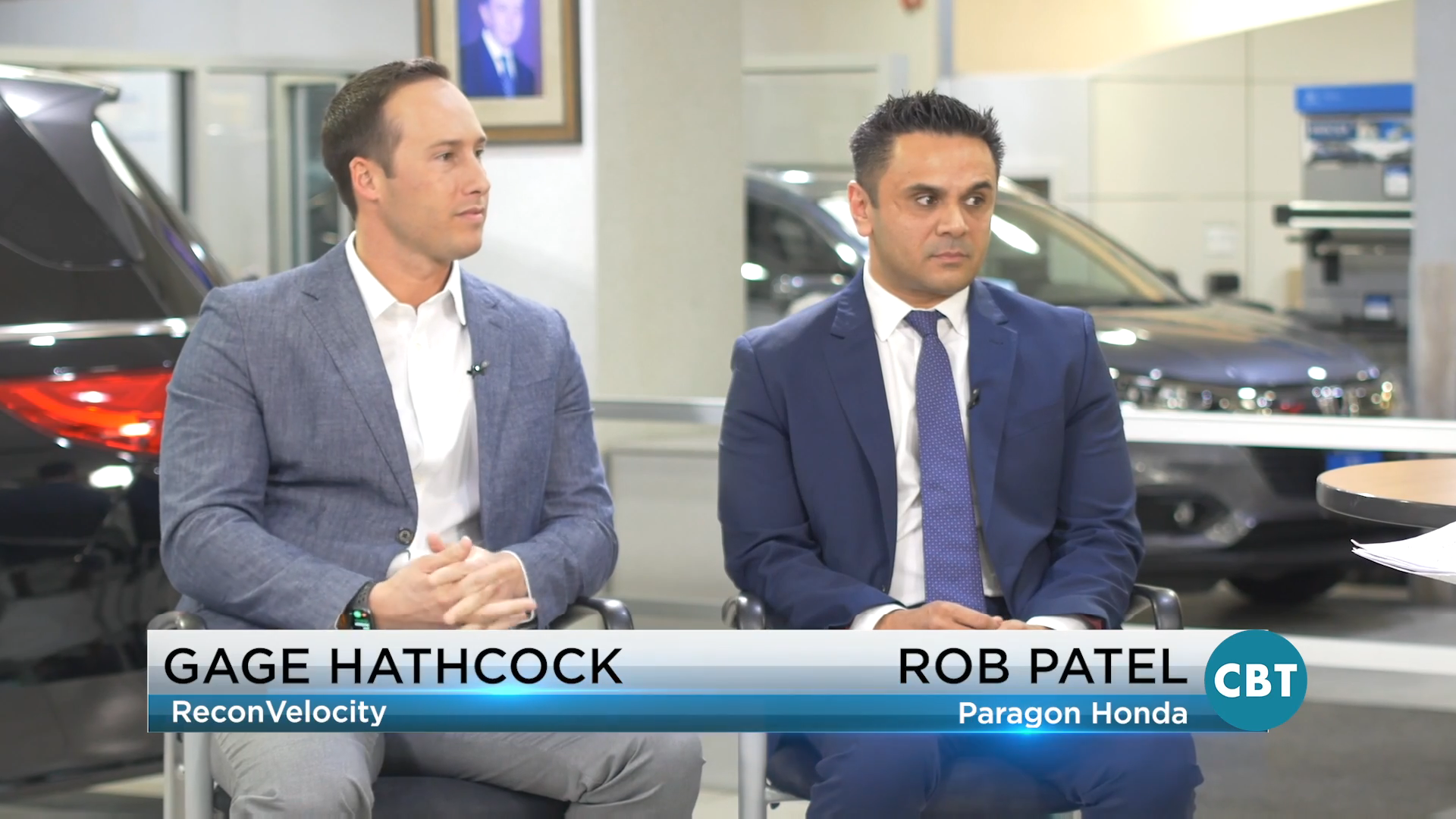In this segment, we’re pleased to introduce Gage Hathcock of ReconVelocity and Rob Patel, Auto Remarketing Specialist at Paragon Honda. Jim, Rob, and Gage discuss acclimating to their new recon process by conducting tests in their smaller-volume Acura store and transitioning it into their much larger-volume Honda dealership. Gage further covers the topic of supporting a move as big as this and addresses what to expect when experiencing a transition to ReconVelocity. Tune in to find out more.
Jim Fitzpatrick: Hi everyone. Jim Fitzpatrick. We’re on location here at Paragon Honda in New York. Thanks gentlemen for joining me. Mr. Rob Patel, who is the used car manager here at Paragon Honda and Gage Hathcock with ReconVelocity. Thank you so much gentlemen for joining me.

Rob Patel: Thanks for having us.
Gage Hathcock: Thank you.
Jim Fitzpatrick: Sure. So you guys just made a big move over to ReconVelocity. Talk to us about that.
Rob Patel: So we started beta testing it in our Acura store, which was a small volume store. A couple of months back, we started evolving the tool into our daily integration of what we like to do on our recon steps. Gage and his team have been ultra helpful, hands-on and helping us acclimate the entire tool into what we’re doing today, in Acura. Today’s a good day because we actually decided to move them now into the Honda store, which is a much higher volume store, and fully integrate them into our recon process. We’ve moved on from Rapid Recon that we were with for about a year and a half or so.
Jim Fitzpatrick: Okay. Okay. Big move for a dealership to make a shift like this, right? You look for a company and a provider that’s going to make it a seamless transition. Right? Because you don’t want to have any downtime.
Rob Patel: Absolutely. And especially with being the number one Honda store in the country, in CPO sales. The number one in Acura and CPO sales, we want to make sure that the partnership we have with the recon tool that we’re going to use with ReconVelocity, it’s seamless and it makes our overall turn time more efficient.
Jim Fitzpatrick: Okay. How many cars are we talking about that go through recon in a facility like this?
Rob Patel: Between the Honda and Acura store, we’re looking rough, a little over 400 cars a month.
Jim Fitzpatrick: 400 cars a month that go through recon. So what did you do before you had any kind of recon support at all? Any kind of recon software.
Rob Patel: Excel spreadsheets and a lot of manpower.
Jim Fitzpatrick: Right? Which is, for the most part, the dealers that are listening to us right now, they’re shaking their heads going, “That’s what we’re doing right now.” Right? And very inefficient program. I mean that-
Rob Patel: Unefficient and very costly.
Jim Fitzpatrick: Yeah. Yeah. For sure. Talk to us a little bit about, Gage about the support that goes into something like this. I mean it’s a big move for a dealership, and dealers that are out there thinking about a program like this go, “Hey, I don’t want to disrupt my business. What’s the support that’s going to be offered to me from ReconVelocity if we decide to move in this direction? ”
Gage Hathcock: Sure. I mean it really starts in the beginning and it never stops. I mean that’s the main thing is ,right? So in the very beginning, from an implementation standpoint, we work with our guys and work with our clients to figure out from a discovery call type standpoint, and setting up the account as best as we can right out of the gate. And then we come in, own going support. I’ve been here several times at this point now, as you’d mentioned, starting with Acura and moving over to Honda, but it’s never ending, its ongoing. And that’s really what separates us is that support because you’re going to have… we’re going to be transitioning over to this centralized recon facility. I can’t remember if we mentioned that already, but there’s going to be changes, personnel changes, location changes, process changes and it’s never ending.
Jim Fitzpatrick: Right. Right. Talk to me about what some of the primary areas are that you’ve been able to address and improve under a program like this? Under ReconVelocity?
Rob Patel: So it’s giving us the ability to actually get a condition report done, prior to us even acquiring the vehicle through either a trade or off lease. Getting a full notification, transparency on what the car needs before we cut the check for the vehicle.
Jim Fitzpatrick: No kidding.
Rob Patel: Yeah.
Jim Fitzpatrick: Wow. So that really minimizes the downtime. I mean if you’ve got the parts standing by and the necessary vendors to work on that car, of course in and out in no time.
Rob Patel: And a much lower cost.
Jim Fitzpatrick: Yeah. Much lower.
Rob Patel: Which is key in our business.
Jim Fitzpatrick: Right. Right. Everybody wants to, you’re going to get just so much for the car when you sell it, the margin compression has now seeped over to used cars. So it’s really all about how you can get that car in and out for the least amount of money.
Rob Patel: Absolutely.
Jim Fitzpatrick: Right. Yeah. For sure. So talk to us a little bit about a program like this in terms of the sales people and not just the salespeople, but also the sales managers that are involved. I mean it, did you get any kind of pushback from them to say, “Hey, what is this all about? How are we doing this?”
Rob Patel: Anytime you invite anything into a dealership environment. It could be a pen or it could be an application.
Jim Fitzpatrick: That’s right. You’re going to get something, right?
Rob Patel: You’re going to get a little bit of pushback.
Jim Fitzpatrick: Sure.
Rob Patel: But slowly they started integrating it into the sales process. So once a car is appraised at Paragon, the car goes onto Recon Velocity. We do a full condition report of the car. “And if there’s an issue with the initial assessment of the vehicle, we’re able to show the consumer, say, “Hey, we found a, B, C and D, a leak in transmission illegal transmission or a blown gasket or a mean seal that’s leaking. We could show the consumers, “Hey, we plan on giving you X. We have to give you a little bit less because the recon dollars, they weren’t assessed on the initial appraisal.
Jim Fitzpatrick: And now you’ve got the third party credibility?
Rob Patel: And showing transparent, yeah. And we’re showing the live photos, what the technician’s taken and another third party that has no vested interest in the consumer paying extra Y on a car.
Jim Fitzpatrick: That’s for sure. And let’s talk about this new recon, centralized recon concept. What’s the idea behind that and what will that bring to the table?
Rob Patel: So the idea behind that, it’s efficiency, efficiency, efficiency.
Jim Fitzpatrick: Okay.
Rob Patel: And Gage and his team are not a vendor, they’re a partner. And helping us get that layout in our 30,000 square foot facility, which is 37 miles away from the actual dealership.
Jim Fitzpatrick: 37 miles away.
Rob Patel: Yes.
Jim Fitzpatrick: Wow.
Rob Patel: So we need to be able to communicate with our team there as efficiently as if there were in Queens.
Jim Fitzpatrick: Right.
Rob Patel: And the other part is they’re willing to help us lay out the entire 30,000 square foot facility, where it’s a proper efficient way to actually recon a car. And I think we’re going to migrate to a location, where instead of the technician having to actually do it on the app, once the car moves to the next position, and if the tech forgets the app will do it on it’s on its own. And we’re looking to reduce the head count of how many people we have involved in the actual recon process, and be able to automate the majority of it as well.
Jim Fitzpatrick: Okay. Now you’ve got the dealer’s attention when you said reduce head count, because that can be very expensive. As you know, human capital is probably the most costly thing that a dealer’s got to deal with. Right? And you’re actually able to minimize that under a program like this.
Rob Patel: Using technology to streamline and have less people touching the car.
Jim Fitzpatrick: Right. Right. Which is huge.
Rob Patel: Tremendous.
Jim Fitzpatrick: Today’s consumer wants to know, when that vehicle hits the website, right? They want to come in and buy the car.
Rob Patel: It’s a finished product.
Jim Fitzpatrick: Yeah. Yeah. So then they don’t want to be told when they get to the dealership, some song and dance as to, “Well it’s over here and it’s over here. And we don’t know where it is.” And meanwhile, sometimes the customer standing on the showroom floor for upwards of 45 minutes to an hour, while the sales person goes around and looks for the car. Right?
Rob Patel: And if you’ve come to Queens, that was one of our biggest problems.
Jim Fitzpatrick: Right. So with the centralized recon center, what does this look like down the road? What does success look like for you? Just-
Rob Patel: Success for us will be able to take our original footprint in Queens that allows us to only display 165 cars on the Honda side, and 90 cars on the Acura side. And it’s going to give us another 40% capacity on display online.
Jim Fitzpatrick: That’s huge.
Rob Patel: And so all the other cars will sit in Bradley, New York where once the lot spaces available, the cars will be ordered down as if we’re ordering a new car down for delivery. We’ll be ordering used cars down to be able to be displayed on the loads.
Jim Fitzpatrick: How long have you been in the industry?
Rob Patel: About 20 years.
Jim Fitzpatrick: 20 years. And you’ve probably never seen a program like this before?
Rob Patel: No.
Jim Fitzpatrick: Yeah.
Rob Patel: I mean, and the best part about the program is they’re willing to grow with us, not just grow on their own.
Gage Hathcock: And to that point, I mean we’ve… you guys built the software, I mean the dealers, right? So with us, with [inaudible 00:07:50], I mean if we talk that, I mean the dealers built that quite frankly, we just help them build it.
Jim Fitzpatrick: Sure. Sure.
Gage Hathcock: But they’re going to be the ones really building this.
Jim Fitzpatrick: Because they’re on the front line.
Gage Hathcock: It’s what the dealers want.
Jim Fitzpatrick: It’s real world. Which is-
Gage Hathcock: We come in here, we customize it or part of this ground up a building of the process for the centralized steel that we’re talking about, and it’s what works for them, right? We’re going to come in, we are going to obviously offer feedback from hundreds of other stores. But I mean this one’s a unique situation and it’s a great challenge to be able to come in here and take somebody that’s already doing a great job, but then wants to double it. What they’re doing now, right? And so we’re talking reducing head count and reducing resources, but if they’re trying to double volume, maybe it just keeps them from having to double resources and double the head count.
Jim Fitzpatrick: Sure. Absolutely. What do you say, Rob to the dealer that’s listening to this conversation right now that’s thinking about this. What are some of the questions they need to ask themselves before bringing in a program like this into the dealership?
Rob Patel: The one person that brings this software into the dealership has to completely embrace it and believe that whatever they put into is what they’re going to get out of it. I mean a lot of people in this industry are afraid of technology. They feel it’s going to take away their job. And by me saying reduce head count, it doesn’t mean I’m looking to eliminate people. It means that I’m looking to increase the volume to the point where it is a reduced headcount with the same amount of people that are there.
Jim Fitzpatrick: Right. Right.
Rob Patel: So don’t be afraid-
Jim Fitzpatrick: There’s been a lot of repurposing of people-
Rob Patel: And personality, yeah.
Jim Fitzpatrick: In industry, right?
Rob Patel: We’ve taken guys that were just doing body shop. Now they’re not doing body shop anymore because it’s more transparent on our reconditioning process, what we need to do. So they just repurpose it in the store.
Jim Fitzpatrick: Yeah. Gage, talk to me a little bit about where this software is today with regard to the recon department, the recon industry, if you will, versus maybe some of the other things that we saw come down the pike maybe 10 or 15 years ago from the industry, maybe from the CRM standpoint.
Gage Hathcock: Yeah, I mean it’s still new, right? To a degree. It’s new. It’s kind of uncharted area. We’re building this new area of the process. But it’s where CRM and internet leads, where 15, 20 years ago. Right?
Jim Fitzpatrick: Right.
Gage Hathcock: So most dealers didn’t think that they had to have it and internet leads are going to go away. Right?
Jim Fitzpatrick: Right.
Gage Hathcock: Internet leads are going to go away. I don’t need a CRM-
Jim Fitzpatrick: Just a fab.
Gage Hathcock: To sell a car I don’t need… I can sell a car without this. Right? And that’s where we’re at now as we’re reconning cars without this.
Jim Fitzpatrick: Yeah. Yeah.
Gage Hathcock: I mean, could you imagine selling a car now without a CRM or a desking tool or managing internet leads without a tool. I mean, that’s where it is. And this is really the next biggest thing for a dealer, that it’s going to be for everybody.
Jim Fitzpatrick: Right. And it’s a no brainer. I mean, what this saves dealers in the way of floor plan costs and getting the vehicle ready for retail is just monumental, right?
Gage Hathcock: Yeah. The ROI on it is huge. And a lot of it’s just really kind of out of sight, out of mind. It’s not one of those ones that you see come in on the contract with a gross on a deal or something. This is kind of that stuff a little behind the scenes that this brings out to the forefront.
Jim Fitzpatrick: That’s right.
Gage Hathcock: So initially when it comes out, we get a little sick. Right? It’s like, “How did we miss that?” The shame on you deal for missing this-
Jim Fitzpatrick: That’s right. That’s right.
Gage Hathcock: But it’s huge.
Jim Fitzpatrick: It really is.
Gage Hathcock: And we’re extremely excited to be working with our dealers.
Jim Fitzpatrick: Great.
Gage Hathcock: To fix it.
Jim Fitzpatrick: Yeah, for sure. So when a program like this came in, how many days in inventory did you think the cars were, by the time they were ready to be sold?
Rob Patel: The reality of where we were, and where we thought we were, was kind of a headache that took a few days to go away.
Gage Hathcock: Yeah. It’s always funny going into a store. They’ve got the time but, just as recently as this week, we had a store install and they found a car that was in there for 40 something days that they’ve lost. Right? So you find the car and they’d completely forgotten about, not these guys-
Jim Fitzpatrick: Yeah. Yeah.
Gage Hathcock: But the store that we installed this week, it was a lost car. 40 something days old.
Jim Fitzpatrick: That’s crazy.
Gage Hathcock: You know what I mean.
Jim Fitzpatrick: That’s crazy.
Gage Hathcock: I told him he owed me a little bit more.
Jim Fitzpatrick: Yeah. Right. He just found you a car.
Gage Hathcock: Yeah. I found him a car, so-
Jim Fitzpatrick: You just found him a car. Right? That’s pretty cool. Well, Rob Patel, used car manager at Paragon Honda and Gage Hathcock, ReconVelocity. For those of you that are thinking about a program like this, that might be the right fit for your dealership, go buy ReconVelocity’s booth at NADA. You’ve got to check it out. You owe it to yourself. You owe it to your recon department. You owe to your used car manager. If you are a used car manager, you owe it to yourself to make your life easier. So a ReconVelocity at NADA. Put it on your list now. Gentlemen, thank you very much. I appreciate it.
Gage Hathcock: Thanks.
Rob Patel: Thanks for having us.
Jim Fitzpatrick: Thanks.
CBT Automotive Network. The number one most-watched network in retail automotive. This has been a JBF Business Media production.








